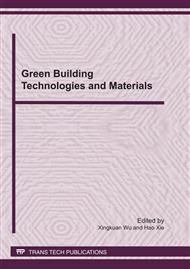[1]
S.Y. Zhang and Y.P. Wang. Production Technology Discussion of Bamboo Charcoal Modified Fine Denier Polyerster Filament [J], Polyester Industry, Vol. 22, (2009), pp.28-31.
Google Scholar
[2]
Q.S. Li, M.S. Xu and G.J. Zhou et al. Preparation and Characterization of White Bamboo Charcoal PET fiber [J]. Chinese Chemical Letters, Vol. 21, (2010), pp.995-998.
DOI: 10.1016/j.cclet.2010.01.022
Google Scholar
[3]
Q. R. Tong. Development and Application of PET Stapled Fiber Modified by Active Charcoal [J]. Synthetic Fiber in China, Vol. 3, (2006), pp.38-43.
Google Scholar
[4]
T.H.C. Costa, M.C. Feitor and C. Alves Jr. et al. Effects of Gas Composition During Plasma Modification of Polyester Fabrics [J]. Journal of Materials Processing Technology, Vol. 173, (2006), pp.40-43.
DOI: 10.1016/j.jmatprotec.2005.11.008
Google Scholar
[5]
X. G Ma, X.Y. Guo and L.X. Gu. Rheological Behaviour in Blends of PET with Ionomeric Polyester [J]. European Polymer Journal, Vol. 43, (2007), pp.3613-3620.
DOI: 10.1016/j.eurpolymj.2007.05.041
Google Scholar
[6]
J.Z. Liang. Tensile and Impact Properties of Hollow Glass Bead-filled PVC Composites [J]. Macromolecular Material Engineer, Vol. 287, (2002), pp.588-591.
Google Scholar
[7]
J.Z. Liang. Mechanical Properties of Hollow Glass Bead-filled ABS Composites [J]. Journal of Thermal Composite Materials, Vol. 18, (2005), pp.406-407.
DOI: 10.1177/0892705705051899
Google Scholar
[8]
H. Zhang and M.J. Liu. Study on Rheological Behaviour of Filled Polymer [J]. Plastics Science and Technology, Vol. 2, (2001), pp.48-53.
Google Scholar
[9]
H.B. Lu and Y.L. Yang. Advances in the Rheology of Filled Polymer Melts [J]. Polymer Bulletin, Vol. 6, (2001), pp.18-26.
Google Scholar
[10]
J. Guo, D.Z. Xu and Y.F. Cai et. al. The Study of Rheological Properties of Flame Retardant Copolyester with Phosphonium [J]. Journal of Textile Research, Vol. 23, (2002), pp.26-29.
Google Scholar
[11]
S.L. Li, Z.J. Qin and B. Li. Study on Melt Rheological Properties of LLDPE/ nano-ZnO Composites [J]. Plastics Science and Technology, Vol. 38, (2010), pp.51-53.
Google Scholar
[12]
R. Wang, R.R. Wu and D.S. Zhang et. al. Study on the Rheological Behaviour and Spinnability of PET/nano-SiO2 composites [J]. Journal of Beijing Institute of Clothing Technology, Vol. 24, (2004), pp.6-9.
Google Scholar
[13]
Han C.D. Rheology in Polymer Processing. New York: Academic Press, (1976), chapter I.
Google Scholar
[14]
Q.Y. Qi, W.M. Qin and W.X. Chen. Study on Rheological Behaviour of Low Melting Point Copolyester [J]. Synthetic Fiber in China, Vol. 28, (2008), pp.22-25.
Google Scholar
[15]
Halidan MAMAT, Wumanjiang AILI. Rheological Behavior of Cellulose Carbamate Solution [J]. Journal of Textile Research, Vol. 30, (2009), pp.1-4.
Google Scholar


